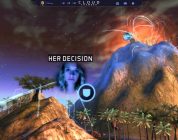Strata Review
Â
When reviewing a developerâs portfolio it can often be misleading and unrepresentative to the current regime or bodies of work. Certainly, when a company develop and expand its workforce, projects can often drift into creative opportunities formally left untouched. This can be an issue for independent game companies as their current projects are often distorted by the audienceâs perception of their previous titles.
Graveck are an Indie team who mainly work from the unity engine. Their portfolio is full of questionable creations, featuring a large amount of smart phone games, which includes an array of generic and overused concepts. It wasnât until viewing Strata, their latest product, that I understood the company had something more to offer.
Strata is a casual puzzle game that appears simple but over the course of time, it reveals a more devious side offering many complicated challenges. The game involves placing coloured ribbons strategically onto a grid to match the pattern, however ribbons have to be implemented in a certain sequence, increasing its difficulty.
The graphics behind this title are simple but effective. The old phrase, âless is moreâ certainly reflects upon the nature of the game. The background appears to be a long piece of fabric that makes up the canvas and as the block coloured ribbons glide across the surface, it allows for a clear definition between foreground and background to be viewed.
The dynamic music works amazingly with the movements on screen. The introduction of new ribbons reveals new tones and harmonics, which add together with the correct sequence to form the whole harmony. The sound is also used as an indicator to inform players when they have mistaken a ribbon in the string of progression. Once a mistake has been made, it punishes you with a note that is out of tune, encouraging you to step back and review your momentum.
Together, the graphics and music builds an elegant and strangely beautiful aesthetic with nothing more then the basic concept of colour and sound. The idea that these factors only work when interacted with allows players to feel fully in control of the environment.
The user interface is unique and innovative, encouraging players to follow the moving ribbons in the menu to their current level set. The game does a great job of making everything feel connected by using the same background and slant that allows for seamless menu transitions. The progression of the ribbon is smooth and strangely calming, like watching a flowing river.
The game itself is a challenge. As you begin to progress, the pattern grid changes from a 2Ã2, gradually evolving into a 6Ã6 as well as subtle changes in the puzzle layout. These are aspects that challenge even the most experienced problem solver, modifying them just enough, each set, to confuse and disorientate. Adding to this, upon discovering a misplaced ribbon twelve maneuvers down the line you have to remove the preceding ribbons to reset the mistake, a similar concept to a Rubikâs Cube. The concept is frustrating and unbelievably difficult forcing players to remember previous attempts.
The replayability within this title involves backtracking to play levels again, with the intension to gain perfect. The player will attempt to not make a mistake and having to remove ribbons from the grid. Unless you are naturally gifted and share the mind-set of the game, you will have to learn the levels, which is no easy task, as the game is unforgiving. Depending on your knowledge of the puzzles will dictate how quickly you can progress to perfect, but either way, you are still looking at hours of work.
A problem I found with the game was the disregard of a progression system. Although I was on the first set of puzzles, you can attempt the last set of levels immediately allowing players the ability to play the hardest levels the title has to offer. This was unfortunate as it game the game no sense of purpose outside of perfecting the game, however, we did receive an early access copy so this issue may have only been for the benefit of the time conscious reviewer.
At the risk of sounding presumptuous, the game feels like it is trying to represent something or has a hidden meaning. It could be representing an idea like the creative process where a series of small actions can create a big change. Using single notes to eventually achieve a chord or a single ribbon that eventually transforms into a piece of clothing is vaguely relatable to the concept behind the game. This is merely speculation on my part but a simple game can lend itself to some wild theories.
Strata is a very well thought out puzzle game that doesnât use complex game mechanics to distract away from the core game play. The use of sound and graphics really envelops players into a beautifully simple world with a comfortable atmosphere. The title doesnât achieve anything ground-breaking but it does a great job at challenging the way in which you think whilst remaining composed and unique.
This game is available on Steam from the 30th of May 2014. I would like to thank the developers for letting Mouse N Joypad early access to this title. We really enjoyed it.
